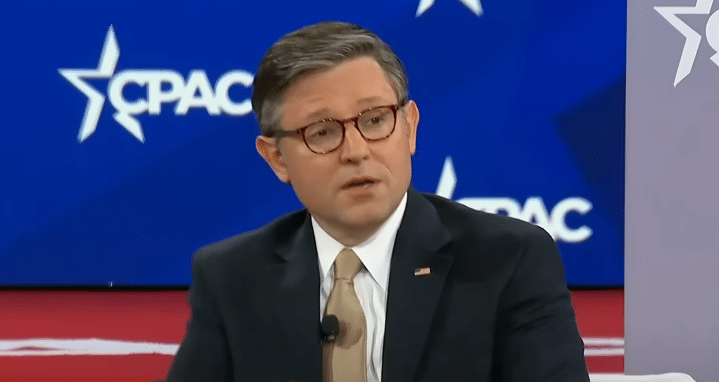
“[P]olitically that would be great for us, you know, it gives everybody a check. But if you think about our core principles, right, fiscal responsibility is what we do as conservatives. That’s our brand. And we have a $36 trillion federal debt, we have a giant deficit that we’re contending with. I think we need to pay down the credit card, right?”
That was House Speaker Mike Johnson’s (R-La.) response on Feb. 20 at the Conservative Political Action Conference (CPAC) to a proposal by President Donald Trump to use 20 percent of savings from any spending reductions derived from identifying waste, fraud and abuse by the White House Department of Government Efficiency (DOGE), the Office of Management and Budget (OMB) and the U.S. Treasury to pay so-called DOGE dividends to taxpayers.
Under the proposal, another 20 percent would be used to paying off the national debt and the remaining 60 percent would be rolled into the following year’s budget to reduce the deficit substantially.
Hypothetically, under Trump’s proposal, if $1 trillion were saved through the one-time cuts, $600 billion would be used for deficit reduction for Fiscal Year 2026, $200 billion to paying down the debt and $200 billion sent back to taxpayers.
What this might do is give taxpayers a vested interest in such spending reductions, since it would mean they would get some say about how the money might have been better spent, Americans for Limited Government President Rick Manning noted in a statement, but that Johnson was generally right that reducing the debt is still the greater priority.
“Speaker Johnson is 100 percent correct in prioritizing ending deficit spending and then paying down the debt with the DOGE dividend. It is easy in Washington, D.C. to spend money on all sorts of good ideas and President Trump is right that the government was wasting the people’s money. However, there are 36 trillion reasons why focusing on ending the deficit and reducing inflation have to be job one, two and three,” Manning said.
Besides the debt, on inflation, the point is well taken. The Consumer Price Index (CPI) rose slightly in January to 3 percent over the past 12 months as former President Joe Biden was leaving office, or at a 0.5 percent rate from the month prior. Overall, consumer prices increased a whopping 21.7 percent from Jan. 2021 to Dec. 2024.

Meanwhile, nominal weekly earnings only increased 20.5 percent. As inflation outpaced earnings, incomes and wages, Americans were definitely not better off than they were four years earlier, one of the major factors that helped President Trump to win a second term in Nov. 2024, and underscoring that inflation is not only a cruel tax, but a non-partisan force that in the past had wiped out Gerald Ford in 1976 and Jimmy Carter in 1980. The same thing might have happened to Ronald Reagan but he ate the recession that came in 1981 and 1982, which combined with high interest rates sopped up the inflation, and thanks to his tax cuts, set up 1983 and 1984 for a solid economic recovery everyone was able to feel.
Then, the key to killing the inflation was pulling money out of circulation. Of which, there are four methods, raising interest rates, raising taxes, strengthening the dollar and the fourth, often ignored, is cutting spending below the current baseline.
On this count, it can be argued that the proposed structure of the DOGE savings — 60 percent for next year’s budget, 20 percent to paying down debt and 20 percent for refunds — is certainly deficit-neutral and in fact has the net effect of reducing the amount of money in circulation. Even if one accepts the premise that the DOGE dividend was merely inflation-neutral, then removing the money from circulation altogether would help reduce inflation.
So, there emerges a question about future inflation. Say, $1 trillion was saved and, of that, $200 billion was returned to taxpayers. Put another way, only $200 billion was spent instead of $1 trillion.
Now, whether the refunds were the cause or not, if inflation remained elevated or increased, voters might end up blaming the DOGE dividends, or Trump’s tariffs, even though increased government revenues from international trade actually take money out of circulation, too. Or voters might blame both.
Politically, former President Joe Biden thought it was a great idea in 2021 to do another round of Covid stimulus, sending hundreds of billions of dollars of more checks to American households, but it proved to be politically counterproductive when inflation increased the same year, reaching 7.5 percent by Jan. 2022 before Russia invaded Ukraine, and peaking at 9.1 percent in June 2022 — paving the way for Democrats’ defeat in the 2022 midterms, losing the House, and ultimately losing the Senate and the White House in 2024, too.
Biden and eventually former Vice President Kamala Harris argued until they were proverbially blue in the face about how they had passed the so-called Inflation “Reduction” Act but savvy voters did not believe it. Similarly, Trump could find that “This time it’s different” on more government checks fall on deaf ears when the 2026 midterms roll around.
Now, that’s all hypothetical, but it likely outlines the political headwinds that come with any proposal that puts any amount of money back into circulation — particularly given the experience of the Covid checks first restoring inflation in 2020 from what otherwise might have been a depression and then exploding it in 2021 and 2022.
Perhaps instead of sending more checks back into circulation while inflation is still elevated and incomes have not caught up with prices, there are other alternatives of what to do with the DOGE dividends.
For example, President Trump could deposit the money into his newly proposed sovereign wealth fund as seed money. And if there was a need to pull even more money out of circulation, he could start by selling some of the $7.3 trillion of intragovernmental holdings of U.S. treasuries the federal government has in various trust funds, and put that on deposit, too.
As Milton Friedman taught, inflation is too much money chasing too few goods, precisely what we had in 2020, 2021 and 2022 as trillions were printed, borrowed and spent into existence while the economy and production ground to a halt and then, later, the economy reopened faster than anticipated and food, energy and other production did not catch up.
The things to do therefore are to increase production and to reduce the money supply and preferably both when dealing with high bouts of inflation, and keep doing them until prices come down and incomes have a chance to catch up. Side effects might include a recession (every other bout of inflation in modern economic history ultimately ended with recessions).
As Biden learned in 2022, inflation is a majority killer. Besides botching the Afghanistan military withdrawal in late Aug. 2021, it is worth noting that Biden’s approval rating was already taking a nose dive in July and early Aug. 2021, plunging into negative territory — never to return.
To avoid such a fate — potentially imperiling Republicans in 2026 and whoever succeeds Trump in 2028 — anything and everything that can be done to soak up the trillions of dollars left over from Covid should likely be undertaken. Sending 20 percent of the money that was already overspent during Covid back into circulation is risky. Trump’s approval rating — positive for the moment — won’t remain positive forever unless prices are brought down.
Robert Romano is the Vice President of Public Policy at Americans for Limited Government Foundation.






